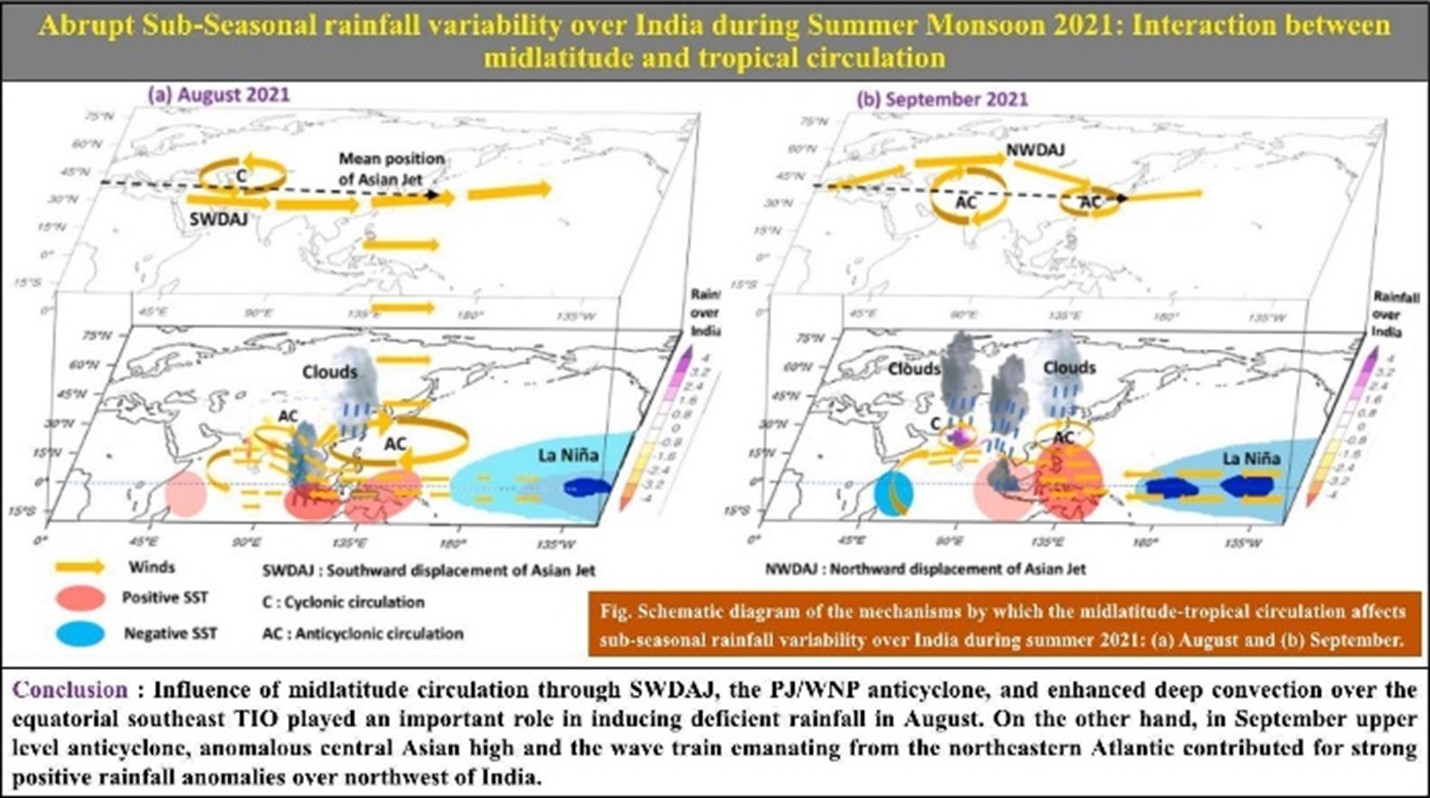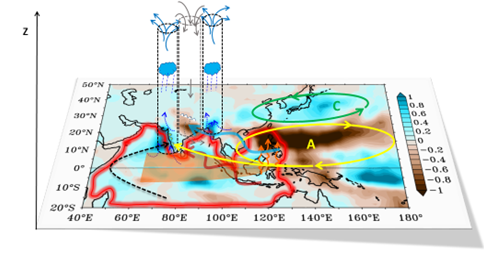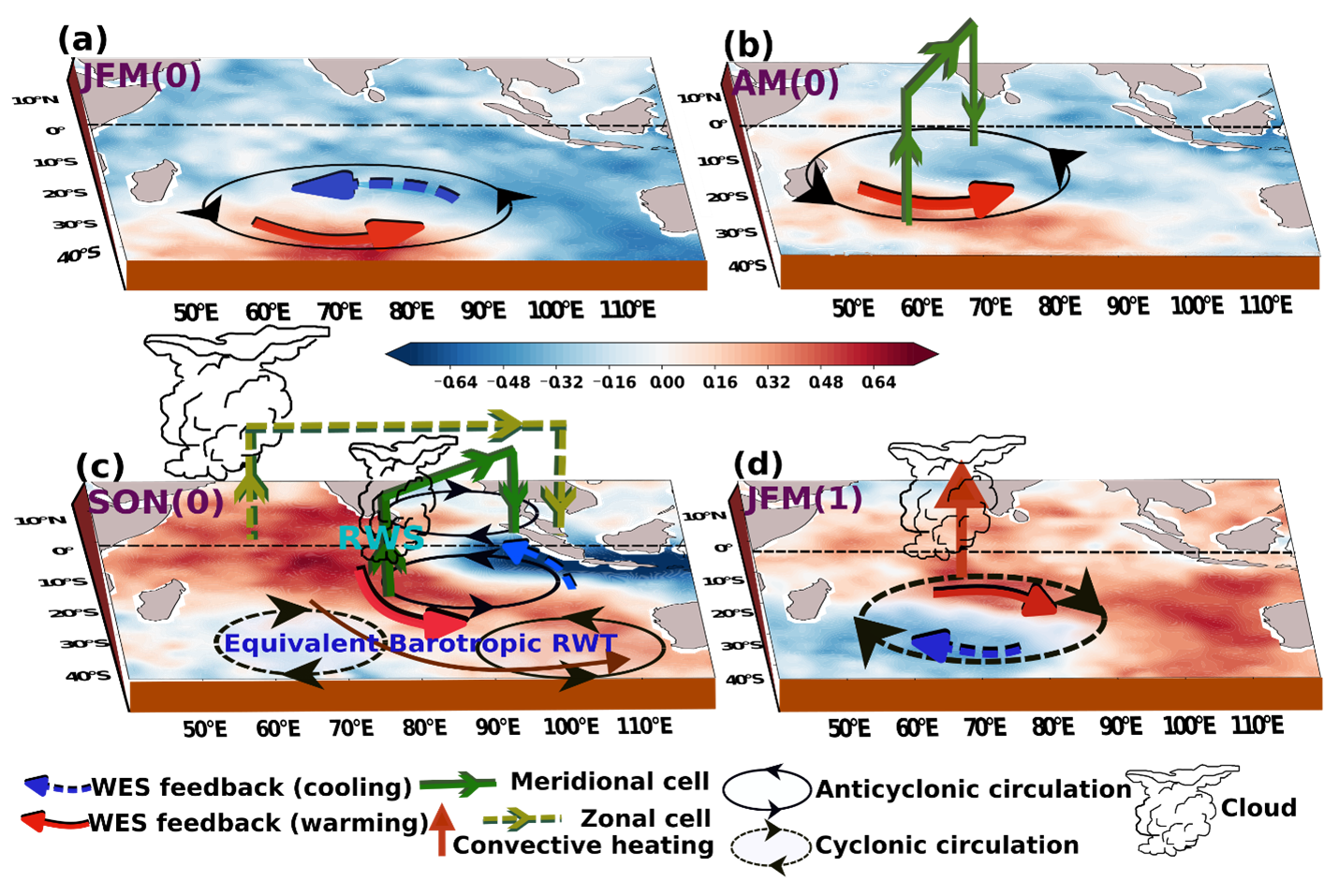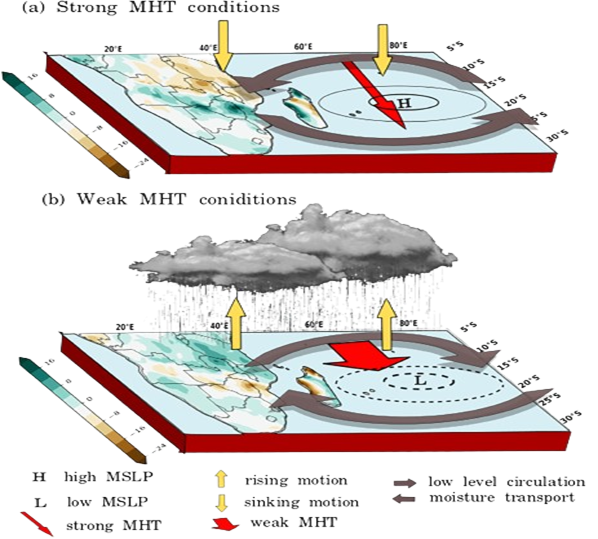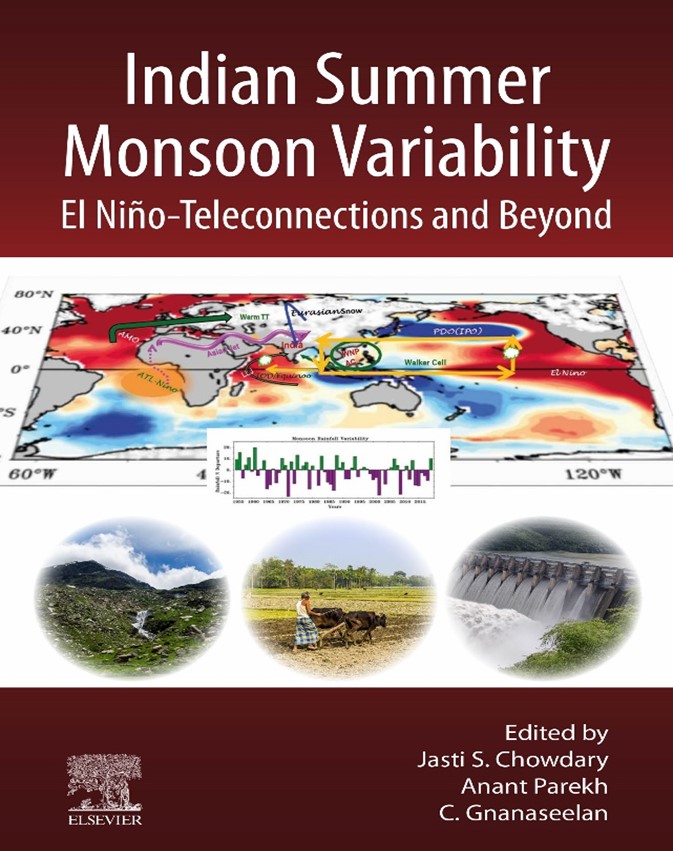
भारतीय उष्णदेशीय मौसम विज्ञान संस्थान
Indian Institute of Tropical Meteorology
पृथ्वी विज्ञान मंत्रालय, भारत सरकार का एक स्वायत्त संस्थान
An Autonomous Institute of the Ministry of Earth Sciences, Govt. of India
Climate Variability and Prediction
Objectives
The objective of understanding mechanisms responsible for Indian monsoon variability on intraseasonal, interannual and inter-decadal time scale is proposed to be achieved through diagnostic studies as well as modelling and simulation studies. In particular
-
To develop a decadal climate prediction system (DCPS).
-
To explore decadal variability of climate extremes and prediction.
-
To examine the predictability/simulation skill for summer monsoon rainfall, sea surface temperature, air temperature, sea level etc. in the Coupled Model Intercomparison Project (CMIP) models.
-
To continue ongoing efforts in identifying regional and global climate drivers for monsoon interannual variability and to identify useful predictors.
-
To examine the teleconnections of Indian monsoon rainfall on intra-seasonal , interannual to decadal scale.
-
To develop forecast models for relevant climatic parameters over India on different spatio-temporal scales using empirical/statistical methods as well as downscaling of seasonal forecasts from General Circulation Models (GCMs) with high-resolution regional models.
-
To understand the role of low-frequency feedbacks involving land-atmosphere interactions relevant to interannual variability of the seasonal mean Indian summer monsoon that is governed by internal dynamics leading to the improvement of the representation of Indian monsoon rainfall, soil moisture etc. in the current generation of earth system models.
-
To develop regional climate data products such as daily temperature, rainfall etc on district, state and homogeneous regional scales using latest interpolation techniques for improved climate change detection and attribution.
-
To understand the role of aerosol loading over the Indian region in monsoon interannual variability and its possible implications on the predictability on interannual as well as on intraseasonal time scale.
-
To quantify the various aspects of climate change and variability on intraseasonal, interannual, decadal and century time scales over India and the neighbouring countries, particularly related to the southwest and northeast monsoons.
About Us
Research efforts of scientists in India and outside, in recent decades, have resulted in a considerable advancement in the understanding of monsoon variability on different spatio-temporal scales and possible role of many global climatic factors responsible for such variability. Intense studies have been made separately for different components of the Asian summer monsoon system (South, Southeast, western North Pacific summer monsoon and East Asian monsoon). We propose to understand the impact of changing global atmospheric conditions on the Asian summer monsoon circulation in general and Indian monsoon circulation and associated rainfall in particular. Predictability of Indian summer monsoon is limited by the ‘climate noise’ or ‘internal’ interannual variability (IAV), generated in the region. In order to improve the prediction skill, it is important to understand the physical processes responsible for the ‘climate noise’. It is proposed to try to unravel the physical processes responsible for ‘internal’ IAV of monsoon
In order to improve the forecast models to achieve the limit on potential predictability of seasonal mean monsoon, it is important to isolate and quantify the contribution from different climate drivers like ENSO, IOD, PDO, AMO, etc. in relation to the ‘internal’ IAV of the monsoon. Using available observations and high resolution coupled-ocean-atmosphere model, we attempt to isolate the contribution of various climate drivers of IAV of the Indian monsoon. The findings of such studies will guide us to develop better model for predicting monsoon climate.
To examine the impact of changing climate , the basic requirement is to understand the climate variability. We examine and try to understand the variability of Indian monsoon on the time scales of intra-seasonal, sub-seasonal, inter-annual to decades.
In view of the large spatial variability of Indian monsoon the efforts are being made to predict the summer monsoon rainfall on smaller spatial scales such as homogeneous regions, sub-divisions etc.
Project Details
Developmental Activities:
-
CVP group has developed a Decadal Climate Prediction System (IITM-DCPS) based on IITM-ESM.
-
An Ocean Reanalysis has been prepared using IITM-DCPS by nudging the subsurface temperature and salinity for more balanced ocean initial state resulting in minimal model shock and drift in IITM-DCPS.
-
The decadal hindcasts/forecasts are generated from 1980 onwards using IITM-DCPS.
-
IITM is participating in the WMO Lead Centre for decadal prediction as a Contributing Centre.
-
IITM-DCPS shows very high prediction skill for lead 1, 2-5 and 6-10 years) for SST over the Indian Ocean and are comparable with the other Coupled Model Inter-comparison Project phase 5 (CMIP5) and CMIP6 decadal hindcasts from global modelling centres.
-
Completed over 100 years of free run with high resolution IITM-DCPS (T126).
-
Integrated heterogeneous land surface soil classifications (19 categories in place of the default 9 soil categories) in IITM-DCPS.
-
Replaced the default University of Maryland (UMD) 13 vegetation categories with United States Geological Survey (USGS) 24 categories for more realistic portrayal of the model's surface characteristics in IITM-DCPS.
-
Integrated the Moderate Resolution Imaging Spectroradiometer (MODIS) albedo for direct and diffused albedo fields including maximum snow albedo and formulations for diffused sea surface albedo in IITM-DCPS.
-
Introduced vegetation-based surface roughness parameterizations instead of vegetation independent formulations in IITM-DCPS.
-
Refined the model's representation of land-atmospheric coupling in IITM-DCPS.
-
Incorporated the maximum/minimum bounds (constraints) in momentum and heat transfer exchange coefficients in IITM-DCPS.
-
Utilized high-resolution representation of the land surface boundaries, including deep soil temperature, surface roughness length, orography, soil, and vegetation type in IITM-DCPS.
-
A time-varying monthly mean green vegetation fraction dataset has been prepared based on CMIP6 protocol using the Land-Use Harmonization 2 (LUH2) datasets.
-
The radiative effects of aerosols are implemented in by providing stratospheric aerosol properties based on the CMIP6 DCPP (decadal climate prediction project) protocol in IITM-DCPS.
-
Prepared monthly varying stratospheric aerosol (Stratospheric volcanic forcing) and all other forces required for the decadal hindcasts, including greenhouse gas emissions, ozone, solar radiation as per CMIP6 DCPP protocol.
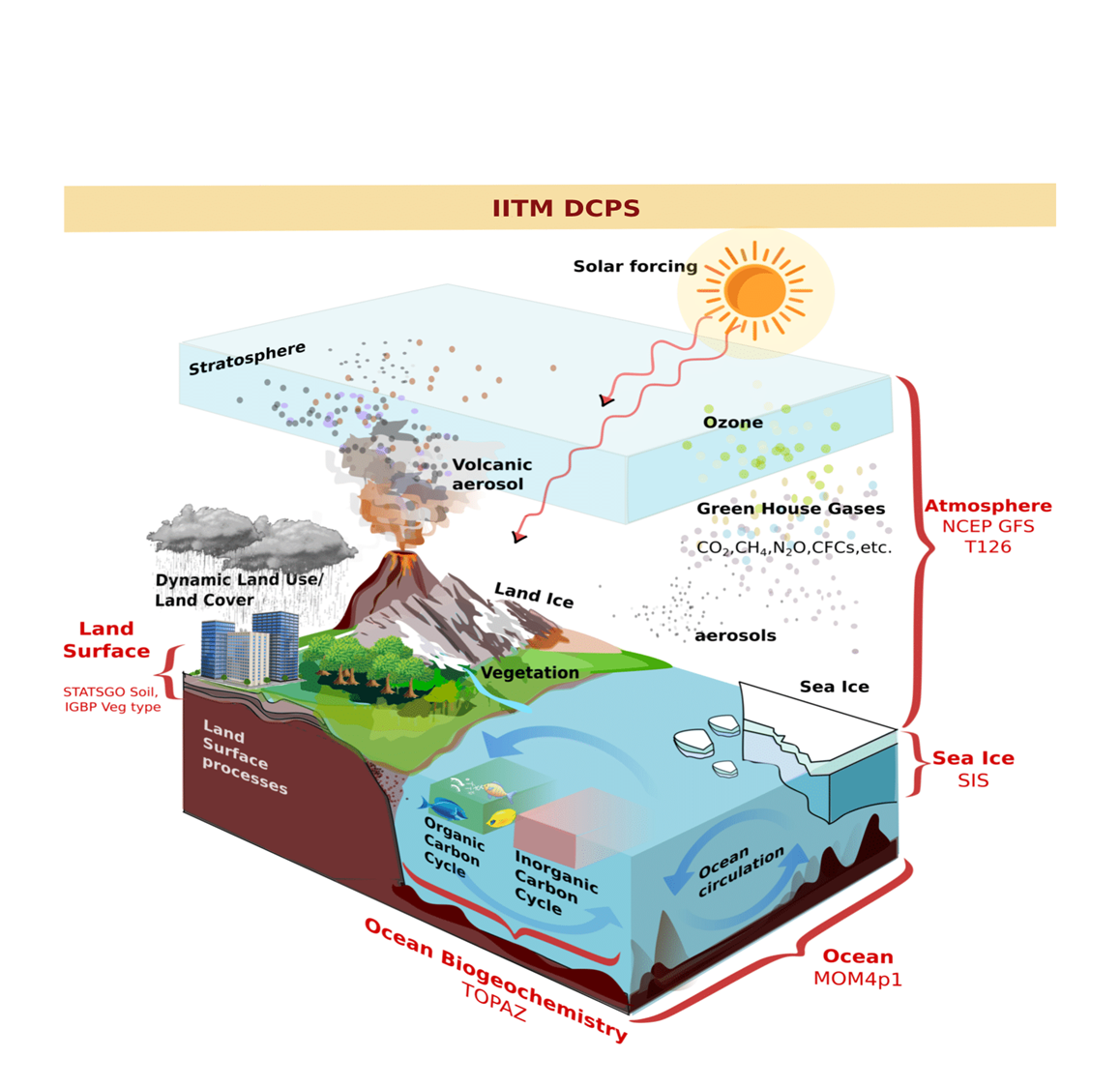
-
Different bias/drift corrections methodologies are explored/applied to enhance the skill of the decadal hindcasts produced in-house as well as CMIP5/CMIP6, with more emphasis to Indian region.
-
Role of north-west Pacific on seasonal and sub-seasonal rainfall variability over Indian land mass is established.
-
Development of web portal CLIMINFO and TEMPINFO: A web portal ‘CLIMINFO and TEMPINFO’ is being developed which will provide all the information on rainfall and temperature variability over a region in one click. The products are being prepared on the spatial scale of sub-divisions, cities and districts and on the time scale of daily, monthly and seasonal. The products are so designed as to be used by the general public as well as farmers. These products would be very useful as inputs to impact assessment groups.
Important Results and Research Highlights
Improvement in the skill of CMIP6 decadal hindcasts for extreme rainfall events over the Indian summer monsoon region
Decadal climate predictions have been widely used to predict the near-term climate information relevant for decision-making at multi-year timescales. In the present study, we evaluate the quality of the Coupled Model Intercomparison Project phase-6 (CMIP6) Decadal Climate Prediction Project (DCPP) hindcasts in capturing the extreme rainfall events (EREs) over the monsoon core region during Indian summer monsoon season (June–September) up to lead years 1–10. For the frst time, in this study, we have used quantile mapping approach to downscale and bias correct the DCPP CMIP6 simulation/hindcast rainfall for the better representation of EREs. Detailed analysis suggests that the models in general strongly underestimate the rainfall variability over the summer monsoon region. However, after the downscaling and bias correction, the representation of rainfall variability and intensity improved multifold. The bias-corrected decadal hindcasts in fact show~ 80% improvement in capturing the frequency, intensity, and spatial distribution of rainfall associated with the EREs. Present study brought out a downscaled DCPP product, with potential prediction skill for EREs over India. It is important to highlight that the models predict an increase in the small and medium-area EREs as compared to the large-area EREs over the monsoon core region for the decade 2019–2028. (Gopinadh Konda, Jasti S. Chowdary, C. Gnanaseelan & Anant Parekh) https://doi.org/10.1038/s41598-023-48268-1
Unusual subseasonal variability of Indian summer monsoon rainfall in 2020
Above-normal all-India summer monsoon (ISM) rainfall was received in 2020 with 109% of its long-period average. According to the India Meteorological Department (IMD), ISM 2020 experienced robust month-to-month rainfall variations; in particular, the peak monsoon month of July 2020 witnessed deficit rainfall. The present study investigated the possible mechanisms that are responsible for the July 2020 deficit rainfall. Analysis revealed that the strong low-level moisture divergence caused by the westward-propagating atmospheric Rossby wave, induced by suppressed western North Pacific (WNP) convection, is primarily responsible for the July rainfall deficit. The WNP suppressed convection is linked to anomalous low-level anticyclonic circulation. It is noted that the intense WNP anticyclone is maintained by the tropical Indian Ocean (TIO) warming-induced atmospheric Kelvin waves and strong low-level convergence over the Meiyu-Baiu rainband. Unlike July, the strength of the WNP anticyclone and TIO warming are weaker in June and August. In addition to the observational analysis, the skill of the Climate Forecast System version-2 (CFSv2) model in predicting the July rainfall at a lead of about two months is examined. Strong positive rainfall anomalies over India are predicted by the model in July, which is in contrast to the observations. Despite predicting the TIO warming, the model failed to capture the westward extension of the WNP anticyclone, which impacted the July rainfall prediction. To understand the importance of the WNP anticyclone on ISM rainfall, a CFSv2 sensitivity experiment is carried out by imposing strong negative sea surface temperature (SST) anomalies over the WNP region to excite the anticyclone. Both the westward extension of the WNP anticyclone and suppressed rainfall over the core monsoon region in July are captured by the model when low-level circulation is imposed. The model sensitivity experiment strongly supports the role of the WNP anticyclone and its westward extension in inducing reduced rainfall in July 2020 over the monsoon trough region. (Patekar Darshana, Jasti S. Chowdary, Anant Parekh, C. Gnanaseelan, T. S. Fousiya, Amol Vibhute, Subrota Halder, Prem Singh, Rashmi Kakatkar) https://doi.org/10.1002/qj.4675
Abrupt sub-seasonal rainfall variability over India during summer monsoon 2021: Interaction between midlatitude and tropical circulation
The Indian subcontinent witnessed abnormal subseasonal rainfall variations during the summer monsoon season 2021 with abrupt change (54%) in rainfall from August to September. According to India Meteorological Department, in August Indian landmass received 81% rainfall of its long period average (LPA), which is lowest since 2002. On the other hand, anomalously high rainfall (+ 35% of its LPA) was received in September. The physical mechanisms responsible for such unusual changes in monthly/subseasonal rainfall are unravelled in this study. In August 2021, the southward displacement of Asian jet (SWDAJ) corroborated by westward and northwestward extension of the Western north Pacific (WNP) anticyclone induced moisture divergence over the monsoon trough region and northwestern parts of India are mainly responsible for the deficit rainfall. In the East Asian region, strong low-level westerly wind anomalies in the northern flank of WNP anticyclone couples with the upper-level westerlies associated with SWDAJ and the resulting interaction due to the barotropic–baroclinic coupling maintains WNP circulation. Apart from WNP anticyclone, anomalous Sea Surface Temperature warming over the southeast equatorial Indian Ocean also contributed to the suppressed rainfall over India. In contrast to August, during September the northward displacement of the Asian jet and associated anomalous upper-level anticyclone over northwest India linked to the mid-latitude wave train emanating from the northeast Atlantic contributed to enhanced rainfall over northwest India. Anomalous upper-level high over central Asia/ northwest of India increased the moist baroclinic instability over northwest India, and enhanced rainfall there. The Climate Forecast System version 2 (CFSv2) model based on May initial conditions is some extent predicted rainfall change from August and September 2021 over India with much lesser magnitude. Inability of the model in capturing the changes in Asian jet, midlatitude wave train and associated teleconnections/interactions to Indian Summer Monsoon (ISM) rainfall limits its prediction skill. Further, the North American Multi Model Ensemble (NMME) models also could predict the correct sign of ISM rainfall anomaly in August and September, with May initial conditions, but failed to capture the spatial patterns, which needs further investigation. (Amol S. Vibhute, Jasti S. Chowdary, Patekar Darshana, Hyo-Seok Park, K. Koteswara Rao, Anant Parekh, C. Gnanaseelan) https://doi.org/10.1016/j.atmosres.2023.106869
Dynamical and moist thermodynamical processes associated with Western Ghats rainfall decadal variability
The Western Ghats (WG) is a vast montane forest ecosystem known for its biodiversity and endemism. The decadal variability of WG summer monsoon rainfall is higher than most of the other regions of India. Spectrum and wavelet analysis of century-long rainfall observation confirm significant decadal variability (at 90% confidence level) in WG rainfall, with amplification of magnitude (about 1.5–2 times) in the recent years compared to the previous half-century. Correlation analysis of WG rainfall with Indian (Pacific) Ocean sea surface temperature (SST) shows a significant relationship during 1901–1942 (1943–1977 and 1978–2010). The analysis associated with decadal rainfall variability reveals the dominance of dynamical processes during 1901–1942 and moist thermodynamical processes during 1943–1977 and 1978–2010. The study concludes that decadal variability of WG rainfall is robust and the forcing mechanisms are essentially maintained by the Indian and Pacific Oceans variability, adding value in developing decadal prediction systems and may also contribute towards understanding the evolution of WG ecosystem. (Subrota Halder, Anant Parekh, Jasti S. Chowdary and C. Gnanaseelan) https://doi.org/10.1038/s41612-022-00232-y
Impact of the Indo-Western Pacific Ocean Capacitor mode on South Asian Summer monsoon rainfall
The influence of Indo-Western Pacific Ocean Capacitor (IPOC) mode on South Asian summer monsoon rainfall variability is investigated. It is found from the observations that the IPOC mode induces a tripole pattern in precipitation anomalies over the South Asian region. Strong positive precipitation anomalies over some parts of western Ghats and Sundarbans and Bangladesh region separated by negative precipitation anomalies over the monsoon trough region are found to be the main characteristic features closely associated with the IPOC mode (Fig. 7). It is noted that anomalous western north Pacific (WNP) anticyclone and tropical Indian Ocean (TIO) warming maintain a tripole precipitation pattern over the South Asian region. Anomalous low level convergence in the northern flank of WNP anticyclone and orographic lift cause enhanced rainfall over the Sundarbans and Bangladesh region. Meanwhile, westward propagating atmospheric cold Rossby wave as a response to suppressed convection over the WNP region induced moisture divergence and downward motion play important role in maintaining negative rainfall anomalies over the monsoon trough region. At the same time, TIO SST warming supported by easterly wind anomalies associated with WNP anticyclone has contributed to the enhanced rainfall over parts of eastern Arabian Sea and western Ghats. Coupled General Circulation Model sensitivity experiments are performed to investigate individual and combined impact of the TIO warming and WNP circulation on south Asian summer monsoon rainfall variability associated with IPOC mode. The model experiments revealed that WNP anticyclone influences the rainfall over the monsoon trough region and Sundarbans-Bangladesh region. Further the moisture convergence induced by local SST warming is mainly helping to sustain enhanced Western Ghats rainfall. Sub-seasonal variability of ISM rainfall associated with the IPOC modes is also discussed. This study advocates the importance of IPOC mode in exerting strong impact on regional summer rainfall variability over the Indian/South Asian summer monsoon region on the interannual time scale. Thus, it is important to consider the possible roles of TIO warming and WNP circulation in predicting the South Asian summer monsoon rainfall. (Jasti Chowdary, Darshana P., G. Srinivas, C. Gnanaseelan and Anant Parekh) https://link.springer.com/article/10.1007/s00382-019-04850-w
Figure 7. Schematic diagram of the mechanisms through which IPOC mode influences Indo-Pacific region in JJA. Shaded region with cyan (brown) colour represents positive (negative) anomalies. Area bounded by red thick closed contour indicates strong positive SST anomalies. Thick yellow (green) ellipse displays anomalous anticyclonic (‘A’) (cyclonic (‘C’)) circulation over tropical (midlatitude) WNP region is part of PJ pattern. Extension of WNP anticyclone to Northern Indian ocean is shown by curved thick yellow arrow. Thick transparent brown (Blue) arrow represents atmospheric warm (cold) Rossby wave. Orange coloured thin upward arrows indicate deep convection process over Maritime continent. Black and grey coloured dashed cylindrical figures over ISM region denote the tripole precipitation pattern. And small arrows at the top of black (grey) cylinders show upper level divergence (convergence) whereas at the bottom of cylinders reversed low level processes. Mean southwesterly cross-equatorial flow over Arabian sea is marked by dashed thick black curved arrow. Wedge shaped transparent orange coloured frame over equatorial Indian ocean displays atmospheric warm Kelvin wave. Thin white (Green) filled wavy pattern denote Western ghats hills (Himalaya range). This figure is prepared based on Chowdary et al. (2019).
Relationship between the Indo‑western Pacific Ocean capacitor mode and Indian summer monsoon rainfall in CMIP6 models
The Indo-western Pacific Ocean capacitor (IPOC) mode is an air-sea coupled mode of variability involving inter-basin interaction between the tropical Indian Ocean (TIO) Sea surface temperature (SST) and western-north Pacific (WNP) atmospheric circulation. The present study examined the fidelity of the World Climate Research Programme’s (WCRP’s) Coupled Model Intercomparison Projects phase-6 (CMIP6) models (40) in representing the relationship between the IPOC mode and Indian Summer Monsoon (ISM) rainfall in historical simulations. Observations show that the positive phase of IPOC mode, linked with WNP anticyclone and TIO warming, induces a southwest-northeast (positive–negative) dipole rainfall pattern over the Indian land region on an interannual timescale. Many CMIP6 models show good skill in capturing the IPOC mode. However, only~30% (12 out of 40) models are able to represent the ISM rainfall patterns associated with IPOC mode well. Physical mechanisms that explain the dipole-like rainfall pattern over India associated with IPOC mode are discussed in those models. It is noted that the persistent SST anomalies in the central equatorial Pacific, and excess cooling over the north Pacific are mainly responsible for the misrepresentation of teleconnections between the IPOC and ISM in many models. The interdecadal modulations between the IPOC mode and ISM rainfall is evaluated in the selected 12 models by means of a 21-year sliding window correlation. Based on this, high correlation epoch (HCE) and low correlation epoch (LCE) are selected for further analysis. The IPOC mode and positive rainfall anomaly over southern peninsular and western India are well simulated in selected models during HCE with some discrepancies. In the case of LCE, most of the models depict overestimated El Niño signals and misrepresented the WNP anticyclone structure, which is not favourable for the development of IPOC mode and relationship with ISM rainfall. It is found that the models in which El Niño signals are overestimated, display a weak IPOC mode and IPOC-ISM relationship. Examining interannual and decadal changes of IPOC mode in Coupled General Circulation Models would be useful for a predictive understanding of monsoon variability and the associated contributing factors other than El Niño. (P. Darshana, Jasti S. Chowdary, Anant Parekh, C. Gnanaseelan) Climate Dynamics (2022) 59:393–415 https://doi.org/10.1007/s00382-021-06133-9
Decadal variability of tropical Indian Ocean sea surface temperature and its impact on the Indian summer monsoon
Decadal variability of climate over the Pacific and Atlantic Ocean is well studied. However, the decadal climate variability over the Indian Ocean and its possible impact on the summer monsoon received relatively less attention. The present study aims to explore the decadal variability of the Tropical Indian Ocean (TIO) sea surface temperature (SST) and its associations with the Indian summer monsoon rainfall (ISMR) variability. More than a hundred years of observed monthly SST data from Extended Reconstructed sea surface temperature and rainfall data from India Meteorological Department are used for the analysis. In addition to these, century reanalysis fields of winds, moisture, vertical velocity, tropospheric temperature, and sea level pressure are used for diagnosing different processes. Time series and wavelet analysis confirmed the presence of decadal variability (~ 9 to 30 years) in the TIO SST. The decadal variance of TIO SST is maximum in the eastern equatorial Indian Ocean, followed by the north Arabian Sea (Figure 11). Decadal EOF of TIO SST shows a dominant basin-wide mode explaining about 50%of total variance and has robust decadal variability during 1940 to 1952; wavelet analysis supported this robust signal statistically. Similar analysis for the ISMR reveals that the decadal variance of rainfall has significant strength over monsoon core zone and Western Ghats. The EOF analysis further confirms this spatial pattern of rainfall decadal variability over India. Correlation between of decadal TIO SST and over monsoon core zone (MCZ) rainfall is significant with 2 years lag. To understand how the decadal variability of TIO SST influences the ISMR, monsoon features during strong warm and cold phase are studied. During the warm phase, MCZ and Western Ghats receive more rain than normal and vice versa for cold phase. Which is consistent with strong southwesterly winds, strong pressure gradient, and strong convergence over the MCZ for the warm phase. Also, during the warm phase, positive anomaly of mid-troposphere temperature, vertical velocity, and moist static energy are found to be associated with excess convective activity. Apart from this, larger scale zonal (Walker) and meridional (Hadley) circulation fields are also in phase with the TIO SST and rainfall variability. Our study advocates that decadal variability in TIO SST influences the monsoon dynamics and moist thermodynamics leading to near in-phase changes in the rainfall over the MCZ and Western Ghats region. (Amol Vibhute, Subrota Halder, Prem Singh, Anant Parekh, Jasti S. Chowdary, & C. Gnanaseelan) Theoretical and Applied Climatology (2020) 141:551–566 https://doi.org/10.1007/s00704-020-03216-1
Coupled feedback between the tropics and subtropics of the Indian Ocean with emphasis on the coupled interaction between IOD and SIOD
The existence of a cyclic feedback between IOD and SIOD through tropical subtropical interaction when ENSO forcing is absent/weak is highlighted. The internal feedback between IOD and SIOD is found to be responsible for the observed biennial tendency in IOD and SIOD. The mechanisms associated with the feedback cycle and the causative factors are unravelled. The positive SIOD induced warming over the southwest subtropical Indian Ocean supports a meridional cell favouring the equatorward expansion of the subtropical anticyclone thereby initiating the equatorial easterlies during the pure IOD years. On the other hand, the southeastward extension of western warming associated with the positive phase of IOD initiates warm anomalies in the northeastern subtropics. The upper level divergence, high absolute vorticity gradient and the associated barotropic Rossby wave source in the southern subtropics then generate an equivalent barotropic Rossby wave pattern in the midlatitudes (Figure 17). The cyclonic circulation associated with this Rossby wave train supports the generation of negative SIOD through wind evaporation SST feedback. (Anila Sebastian and C. Gnanaseelan, Global and Planetary Change, 2023) https://www.sciencedirect.com/science/article/pii/S0921818123000644
Figure 12: Schematic diagram of the cyclic feedback mechanism between tropical and subtropical Indian Ocean from JFM(0) of positive SIOD to the following JFM(1). The red and blue solid arrows represent warming and cooling by the WES feedback mechanism, respectively. The solid circles represent anticyclone, and the dotted circle indicates cyclonic circulation. Rossby wave source (RWS) and equivalent barotropic Rossby wave train (RWT) are shown in panel (c).
Assessment of CMIP6 models' skill for tropical Indian Ocean sea surface temperature variability
The present study examines the ability of Coupled Model Inter-comparison Project phase 6 (CMIP6) models in representing the dominant modes of tropical Indian Ocean (TIO) sea surface temperature (SST) variability on the interannual and decadal time scale. Historical simulations from 27 CMIP6 models are assessed against Extended Reconstructed SST over the period of 1854 to 2014. Spectrum analysis reveals that many models reproduce interannual and decadal variability of TIO SST but underestimate the amplitude of variability with some disparity in the periodicity. All models can reproduce the dominant basin-wide mode of interannual and decadal variability of TIO SST reasonably well. Skill score analysis of TIO SST variability reveals that KACE-1-0-G has highest skill, followed by FGOALS-f3-L, EC-Earth3-Veg-LR, ACCESS-ESM1-5, CanESM5-CanOE on the interannual timescale and FGOALS-f3-L, CanESM5-CanOE, KACE-1-0-G and CanESM5, respectively, showed highest skills for decadal variability. It is found that variations in radiation and latent heat flux are primarily responsible for interannual variability in TIO SST, the basin-wide warming, in the observations. Taylor diagram analysis reveals that all the models exhibit better skill for the radiative flux; however, skill for the latent heat and momentum flux varies from model to model. It is important to note that the models in which the latent heat flux and zonal wind are better represented have produced better TIO SST variability compared to other models. A higher discrepancy in latent heat and zonal momentum flux leads to improper wind-evaporation-SST and wind-circulation-SST feedback, which in turn restricts the model skill. Besides, model that has realistic central and eastern Pacific SST variability show better skill for TIO SST variability in both interannual and decadal time scales. The present study advocates that better representation of latent heat flux and zonal wind in coupled models is important for the accurate simulation of interannual and decadal variability in TIO SST. (Subrota Halder, Jasti Chowdary, Anant Parekh, C. Gnanaseelan, A. Kulkarni– Int. J. Climatology). https://rmets.onlinelibrary.wiley.com/doi/full/10.1002/joc.6975
Atlantic Niño modulation of the Indian summer monsoon through Asian jet
The Indian rainfall and the Atlantic Niño peaks during summer month and have inverse relationship. This relationship has been revisited in the current study and it is found that the Atlantic Niño significantly influences a dipole pattern of rainfall in the north–east and the north-western parts of India. The positive phase of the Atlantic Niño intensifies the inter-tropical convergence zone, as a result of this local tropospheric warming, over the equatorial east Atlantic and west Africa, owing to the enlargement of the upper-troposphere divergence. This provokes meridional stationary wave owing to the stronger meridional transfer of energy, as the influences of background jet-streams are minimal over North Africa and Europe. This results in the consecutive anomalous negative, positive, and negative geopotential heights (GPHs) over the tropical east Atlantic, Mediterranean, and north–west Europe, respectively. The north–west Europe acts as the center of action for the propagation of a Rossby wave train zonally oriented toward central Asia reinforcing positive GPH anomaly over there. The positive GPH anomaly reduces the Asian subtropical westerly jet-stream east of the Caspian Sea, owing to the reduction in the upper-troposphere divergence toward the Indian subcontinent and caused for above (below) normal north–east (north–west) Indian summer monsoon rainfall. The atmospheric general circulation model captures general characteristics of wave pattern and changes in the Asian jet when correlated with Atlantic Niño with considerable skill. (Ramesh Kumar Yadav, G. Srinivas and Jasti S. Chowdary) npj Climate and Atmospheric Science (2018)1:23; doi:10.1038/s41612-018-0029-5
Impact of intra-decadal variability of meridional heat transport on the rainfall over Southern Africa during austral summer
The present study examines the impact of intra-decadal variability of Meridional Heat Transport (MHT) associated with Indian Ocean Shallow Meridional Overturning Circulation (SMOC) on the rainfall variability over Southern Africa (e.g., Zambia, Malawi, Mozambique, south-eastern Congo, Zimbabwe, southern Tanzania and Madagascar) during austral summer (December to February). Century long ocean reanalysis, atmospheric reanalysis and rainfall observations are used for the study. Spectrum analysis of MHT index and rainfall anomaly displays intra-decadal (5–7 years) variability significant at 95% confidence level. The oceanic and atmospheric conditions during strong and weak phases of intra-decadal MHT variability are examined. Strong (weak) MHT years displayed reduction (increase) in Sea Surface Temperature (SST) in southwest Indian Ocean, which are out-of-phase with net heat flux but in phase with ocean circulation. The negative (positive) SST anomaly favours positive (negative) sea level pressure anomaly, which supports the low level moisture divergence (convergence) and anticyclonic (cyclonic) circulation in the lower troposphere. This circulation leads to anomalous subsidence (convection) and below (above) normal moist static energy over the study region resulting in below (above) normal convection, that causes negative (positive) rainfall anomaly over the Southern Africa. The association between intra-decadal variability of MHT associated with SMOC and rainfall over Southern Africa during austral summer are reported for the first time.
The study may pave the way for enhanced predictability of intradecadal Southern African austral summer rainfall. (Rahul U. Pai, Anant Parekh, Subrota Halder, Jasti S. Chowdary, C. Gnanaseelan) https://doi.org/10.1002/joc.8263
Fig. 11 Schematic of mechanism displaying the impact of MHT associated with SMOC on the austral summer rainfall over south Africa at intra-decadal timescale during (a) strong and (b) weak MHT conditions. (Shades over the land is filtered rainfall anomaly [mm·month−1] for the respective phases)
- Published edited book on “Indian Summer Monsoon Variability: El Niño-Teleconnections and Beyond”
Scientists of CVP group have brought out an edited book titled “Indian Summer Monsoon Variability: El Niño-Teleconnections and Beyond” that covers the important aspects of teleconnection pathways of ISM. A wide-spectrum of remote and local forcing mechanisms that potentially affect the ISM rainfall variability from interannual through decadal time scales and the climate change impacts are presented in this book (Fig. 6 shows its cover page). It emphasizes both ENSO and non-ENSO teleconnections to ISM variability. Unlike many other books on the climate variability, this book highlights the potential research problems of relevance in different chapters, which may motivate young researchers and students. It also brings out the existing knowledge gap in the field and recommends the requirement of additional long term observations. The current status of climate models is emphasized in many chapters to possibly help and motivate the modellers to address the challenging issues of climate science and ISM variability. [Chowdary J.S., Parekh Anant and Gnanaseelan C. (Eds.), Indian Summer Monsoon Variability: El Niño-Teleconnections and Beyond, Elsevier, 2021, ISBN: 978-0-12-822402-1, DOI: https://doi.org/10.1016/C2019-0-04482-2]
Recent Publications
- Velivelli S., G. C. Satyanarayana, J. S. Chowdary, G. Srinivas, Patekar Darshana, Gopinadh Konda, Raju Attada, Anant Parekh, C. Gnanaseelan (2025)- “Surface air temperature variability over India in CMIP6 models during spring and early summer: after effect of El Niño.” Climate Dynamics,63, 164 (2025). https://doi.org/10.1007/s00382-025-07654-3
- Vibhute A., Chowdary J. S., Darshana P., Parekh A. and Gnanaseelan C. 2025, “Association between the meridional displacement of the Asian jet and Indian summer monsoon rainfall in CMIP6 models: Impact of El Niño and Pacific decadal oscillation.” Quarterly Journal of the Royal Meteorological Society. Wiley. https://doi.org/10.1002/qj.4976.
- P. Darshana, J. S. Chowdary, Anant Parekh, C. Gnanaseelan, T. S. Fousiya, Amol Vibhute, Subrota Halder, Prem Singh and Rashmi Kakatkar, “Unusual Sub-seasonal Variability of the Indian Summer Monsoon Rainfall 2020, Quarterly Journal of the Royal Meteorological Society, https:/ /doi.org/10.1002/qj.4675
- R.K. Yadav, The recent trends in the Indian summer monsoon rainfall, Environment, Development and Sustainability (ENVI).
- Gnanaseelan C., Kakatkar Rashmi, Anila S., Mohapatra S., Parekh A. and Chowdary J. S. (2024)- “Role of strong subsurface mode on the anomalous basin wide surface warming of the Tropical Indian Ocean in 2019-20”, Journal of Earth System Science.
- De S., Agarwal N.K., Chowdary J.S. and Darshana P. (2024)- “Scale interactions during ENSO – a new dynamical mechanism on unveiling ENSO-monsoon nonlinearity.” Theoretical and Applied Climatology, 2024,https://doi.org/10.1007/s00704-024-05111-5
- Lakshma Kethavath, Gopinadh Konda, J.S. Chowdary, C. Gnanaseelan (2024)- “Biennial variability of boreal spring surface air temperature over India”, Atmospheric Research, https://doi.org/10.1016/j.atmosres.2024.107691
- Satyanarayana G. Ch., Velivelli Sambasivarao, K. Koteswara Rao, J. S. Chowdary, Anant Parekh, and C. Gnanaseelan, (2024)- “Increasing heat waves frequencies over India during post-El Niño spring and early summer seasons”, Global and Planetary Change, 241, 104561, https://doi.org/10.1016/j.gloplacha.2024.104561.
- Priyanka N. Maraskolhe, Ramesh Kumar Yadav (2024)- “Reasons for 2022 deficient Indian summer monsoon rainfall over Gangetic Plain”, Meteorology and Atmospheric Physics, https://doi.org/10.1007/s00703-024-01031-1
- J.S. Deepa and C. Gnanaseelan (2024), On the skill of Indo-Pacific decadal sea level predictions and its connection with skillful AMO and PDO predictions, Climate Dynamics.
- Deepa J.S., Gnanaseelan C. (2024)- “On the skill of Indo-Pacific decadal sea level predictions and its connection with skilful AMO and PDO predictions”, Climate Dynamics, 62, 10363–10380. https://doi.org/10.1007/s00382-024-07456-z
- Gopinadh Konda, J. S. Chowdary, C. Gnanaseelan, N. K. Vissa and Anant Parekh (2024)- “Near-term prediction of surface temperature extremes over India in the CMIP6-DCPP models”, Climate Dynamics, https://doi.org/10.1007/s00382-024-07472-z.
- Mahendra N, Nagaraju Chilukoti, J. S. Chowdary, Raju Attada, Ravi Kumar Kunchala, Prasad K. Bhaskaran (2024)- “Contrasting influence of the 1997 and 2015 El Niño on the Indian Summer Monsoon Rainfall: Role of the Southern Hemisphere, Global and Planetary Change, 104601, https://doi.org/10.1016/j.gloplacha.2024.104601.
- Piyali Goswami, Hitesh Gupta, Rahul Deogharia, Sourav Sil and Saikat Pramanik- “Contributions of upper layer processes on the mixed layer temperature in the Bay of Bengal using relative importance methods.” Ocean Dynamics (2024). https://doi.org/10.1007/s10236-024-01641-8
- Ramesh Kumar Yadav, “Impact of the Indo-Pacific Warm Pool warming on Indian summer monsoon rainfall pattern” ; International Journal of Climatology, 2024, DOI : 10.1002/joc.8691
- Pathmarasa Kajakokulan, Raju Attada, Dzung Nguyen-Le, Jasti S. Chowdary (2024)- “Impacts of two types of El Niño events on Spring Surface Air Temperature over Sri Lanka”, Dynamics of Atmospheres and Oceans, 2024,101517, https://doi.org/10.1016/j.dynatmoce.2024.101517.
- Dr. Ramesh K. Yadav, “Impact of the Indo-Pacific Warm Pool warming on Indian summer monsoon rainfall pattern"; International Journal of Climatology; 2025 Volume 45, Issue 1, Jan 2025, e8691, DOI: 10.1002/joc.8691
- Hrudya P. H, Gopinadh Konda, J. S. Chowdary, C. Gnanaseelan and Anant Parekh (2025) “Multi-decadal variations of Severe Cyclonic Storm frequency over the Bay of Bengal and associated mechanisms.” International Journal of Climatology, 1–13 https://doi.org/10.1002/joc.8754
- Vinodhkumar B., Rao K.K., Sayeekrishnan H., Krishna Kishore Osuri, U. N. Athira, Desamsetti Srinivas, J. S. Chowdary and T. V. Lakshmi Kumar (2025) “How well the bias-corrected CMIP6 models assess the extreme precipitation indices over India?”. Model Earth Syst. Environ. 11, 45. https://doi.org/10.1007/s40808-024-02261-3
- Kesireddy Lakshman, Raghu Nadimpalli, Akhil Srivastava, K. K. Osuri, Raju Attada, Anant Parekh, - “High-Resolution Analysis of Severe Heat Wave Dynamics and Thermal Discomfort Across India”, Int. Journal of Climatology, 2025; 0:1–18 https://doi.org/10.1002/joc.8753
- Amita Kumari, Raju Attada, J. S. Chowdary, Nimmakanti Mahendra, Nagaraju Chilukoti, Rama Krishna Karumuri, (2025)- “Recent decades witness a strong east-west gradient of monsoon precipitation changes over Northern India”, Atmospheric Research, 108014, https://doi.org/10.1016/j.atmosres.2025.108014.
- Increasing heat waves frequencies over India during post -El Niño spring and early summer seasons”, Global and Planetary Change
(G.Ch. Satyanarayan, S. Velivell, K. K. Rao, J. S. Chowdary, A. Parekh, C.Gnanaseelan (2024), Global and Planetary Change https://doi.org/10.1016/j.gloplacha.2024.104561 - Understanding satellite-derived groundwater dynamics and its association with hydrological processes over India during excess and deficit monsoon years.
(Bushra Shaikh, Anant Parekh and C. Gnanaseelan, Hydrological Processes, 38: e15255, August 2024, DOI:10.1002/hyp.15255, 1-21) - Evaluation of the Skill of CMIP6 models in simulating the interannual variability of Subtropical Indian Ocean SST in present climate.
(Sebastian Anila and C. Gnanaseelan, Theoretical and Applied Climatology”, 2024, https://doi.org/10.1007/s00704-024-05125-z) - Role of strong subsurface mode on the anomalous basin-wide surface warming of the Tropical Indian Ocean in 2019–2020
(C. Gnanaseelan, Rashmi Kakatkar, S. Anila, S. Mohapatra, A. Parekh, J.S. Chowdary, Journal of Earth System Science, (2024) 133:143, https://doi.org/10.1007/s12040-024-02360-w) - A new dynamical mechanism on unveiling ENSO-monsoon nonlinearity
(De S., Agarwal N.K., Chowdary J.S. and Darshana P. (2024) Theoretical and Applied Climatology, 2024, https://doi.org/10.1007/s00704-024-05111-5 - Temporal and spatial aggregation of rainfall extremes over India under anthropogenic warming
(Gopinadh Konda, J. S. Chowdary, C. Gnanaseelan, N. K. Vissa & A. Parekh, Scientific Reports. https://www.nature.com/articles/s41598-024-63417-w) - Variability of summer monsoon depressions over the Bay of Bengal with special emphasis on El Nino cycle
(Chowdary J.S., Mahendra N., Konda G., Chilukoti N., Parekh A., Gnanaseelan C., Climate Dynamics, April 2024, DOI:10.1007/s00382-024-07245-8, 1-13) - A Case Study of deviant El Niño Influence on the 2023 Monsoon: An Anecdote Involving IOD, MJO and Equivalent Barotropic Rossby Waves
(Mahendra N., Nagaraju C., Nagaraju, J. S. Chowdary, S. Renuka, June, 2024- Climate Dynamics. https://doi.org/10.1007/s00382-024-07273-4 - Recent Two Decades Witnesses an Uptick in Monsoon Depressions over the Northern Arabian Sea.
(Nagaraju Chilukoti, Mahendra N, and J.S. Chowdary (2024)- “npj Climate and Atmospheric Science 7, 183. https://doi.org/10.1038/s41612-024-00727-w) - Impact of the Pacific-Japan pattern on the tropical Indo-western Pacific Ocean Surface Waves.
(Srinivas G, Remya P. G., Subhra Prakash Dey, J. S. Chowdary and Prashant Kumar (2024)- “” Climate Dynamics”, https://doi.org/10.1007/s00382-024-07357-1 - Delayed impact of El Niño on the spring surface air temperature over India
(Velivelli S., Satyanarayana G.C., Chowdary J.S., Koteswara Rao K., Parekh A., Gnanaseelan C., Climate Dynamics, 62, March 2024, DOI:10.1007/s00382-023-06990-6, 1715-1728 -
Unusual subseasonal variability of Indian summer monsoon rainfall in 2020
(Patekar Darshana, Jasti S. Chowdary, Anant Parekh, C. Gnanaseelan, T. S. Fousiya, Amol Vibhute, Subrota Halder, Prem Singh, Rashmi Kakatkar) 2024, DOI: 10.1002/qj.4675 -
Improvement in the skill of CMIP6 decadal hindcasts for extreme rainfall events over the Indian summer monsoon region
(Konda G., Chowdary J.S., Gnanaseelan C. and Parekh A.) Scientific Reports, 13: 21737, December 2023, DOI:10.1038/s41598-023-48268-1, 1-134363 -
Impact of intra-decadal variability of meridional heat transport on the rainfall over Southern Africa during austral summer
(Pai R.U., Parekh A., Halder S., Chowdary J.S., Gnanaseelan C.,) International Journal of Climatology, 43, December 2023, DOI:10.1002/joc.8263, 7256-72734387 -
Abrupt sub-seasonal rainfall variability over India during summer monsoon 2021: Interaction between midlatitude and tropical circulation
(Vibhute A.S., Chowdary J.S., Patekar D., Park H.S., Koteswara Rao K., Parekh A., & Gnanaseelan C.) Atmospheric Research, 292:106869, September 2023, DOI:10.1016/j.atmosres.2023.106869, 1-184288 -
A new approach for seasonal prediction using the coupled model CFSv2 with special emphasis on Indian Summer Monsoon
(Fousiya T.S., Gnanaseelan C., Halder S., Kakatkar R., Chowdary J.S., Patekar D., Parekh A.) International Journal of Climatology, 43, September 2023, DOI:10.1002/joc.8126, 4944-49644348 -
Coupled feedback between the tropics and subtropics of the Indian Ocean with emphasis on the coupled interaction between IOD and SIOD
(Anila S., Gnanaseelan C.) Global and Planetary Change, 223: 104091, April 2023, DOI:10.1016/j.gloplacha.2023.104091, 1-154240 -
Symmetric and asymmetric response of Indian Summer Monsoon rainfall to different ENSO decay phases in observations and CMIP6 models
(Chowdary J.S., Saikrishna T.S., Dandi R.A., Patekar D., Parekh A., Gnanaseelan C., Osuri K.K.) Global and Planetary Change, 220: 104000, January 2023, DOI:10.1016/j.gloplacha.2022.104000, 1-204203
Team
Climate Variability and Prediction
Project: Climate Variability and Prediction
Project Director: Dr. C. Gnanaseelan, Scientist-G
Scientist-D
rashmi@tropmet.res.in
Phone No - +91-(0)20-25904239
View profile
Scientist-B
saikat.pramanik@tropmet.res.in
Phone No - +91-(0)20-25904278
View profile

(Stenographer-III)
omkar.raparti@tropmet.res.in
Phone No - +91-(0)20-25904702

(Project Scientist-III)
rajesh.pv@tropmet.res.in
Area of Research: -
- Indian summer monsoon variability and Trends using advanced climate models and observation.
- Contributing to enhancing the decadal prediction capabilities of the monsoon through the IITM-DPS modeling framework.

(Project Scientist-II)
darshana.jrf@tropmet.res.in
Area of Research: -
- Asian monsoon multi-timescale variability and Monsoon Teleconnection,
- Ocean-atmospheric Coupled processes,
- Indo-Pacific Climate variability and prediction on different timescales,
- Coupled climate modeling.

(Project Scientist-II)
rosimitha.panda@tropmet.res.in
Area of Research: -
- Regional Climate Modelling,
- Monsoon variability and predictability, Land surface process
- Climate modelling.

(Project Scientist-II)
rahul.pai@tropmet.res.in
Area of Research: -
- Ocean Meridional Overturning Circulation,
- Ocean Meridional Overturning Circulation,
- Climate Variability,
- Coupled climate modeling.

(Project Scientist-II)
anila.sebastian@tropmet.res.in
Area of Research: -
- Large scale Air-Sea interaction,
- Ocean Dynamics,
- Indian Summer Monsoon Dynamics,
- Coupled Climate Modelling.

(Project Scientist-II)
vineet.singh@tropmet.res.in
Area of Research: -
- Ocean-cyclone interaction and changes in global cyclone activity in a changing climate.

Roma Varghese
(Project Scientist-II)
roma.varghese@tropmet.res.in
Area of Research: -
- Ocean-atmosphere-land interactions
- Hydroclimate variability
- Physical Oceanography
- Environmental impacts of climate variations and change through monsoon rainfall and vegetation of the Indian sub-continent
- Vegetation Modelling

(Project Scientist-II)
bushra.shaikh@tropmet.res.in
Area of Research: -
- Hydro-Meteorology,
- SWAT Modeling for water budget components,
- Meteorological driven Groundwater Dynamics,
- Contaminant Transport Modeling,
- Analytical and Numerical Modeling techniques for Groundwater and Surface Water Interaction

Amit Kumar Sharma
(Project Scientist-II)
amitksharma@tropmet.res.in
Area of Research: -
- Aerosol interactions in Earth System
- Climate modelling
- Radiative Forcing

(Project Scientist-I)
amol.vibhute@tropmet.res.in
Area of Research: -
- Monsoon interconnections,
- Mid-latitude tropical interaction, Decadal prediction,
- Climate modelling,
- Air-sea interaction

(Project Scientist-I)
rushikesh.adsul@tropmet.res.in
Area of Research: -
- Tropical cyclones
- Air-sea interaction

Neha Hikare
(Project Scientist-I)
neha.hikare@tropmet.res.in
Area of Research: -
- Extreme Events,
- Indian Summer Monsoon
- Climate Modelling,
- Aerosol and Precipitation Chemistry.

(Project Scientist-I)
biswajit.jena@tropmet.res.in
Area of Research: -
- Tropical Cyclones,
- Numerical Modeling,
- Climate Modeling

(Project Scientist-I)
madhu.kaundal@tropmet.res.in
Area of Research: -
- Southern Indian Ocean,
- Cyclone frequency and intensity,
- Ocean dynamics role in cyclone activity

(Project Scientist-I)
rahul.singh@tropmet.res.in
Area of Research: -
- Monsoon Dynamics,
- Dry Air Intrusion, Tropical Cyclones,
- Climate Change

(Research Associate)
shivani.gond@tropmet.res.in
Area of Research: -
- Compound Extremes,
- Climate Variability, Climate change Impact assessment.

(Research Associate)
ganadhi.kranthi@tropmet.res.in
Area of Research: -
- Tropical Cyclone (TC) studies over the North Indian ocean,
- Numerical Weather Prediction Models to study inner core processes of TCs,
- Downscaling GCMs to Study Cyclone Risk,
- Ocean-Atmosphere interaction of TCs,
- Changes in frequency and intensity of TCs in a changing climate.

(Research Associate)
masud.kawsar@tropmet.res.in
Area of Research: -
- Paleoclimatology,
- Paleoceanography,
- Time series analysis,
- Indian Monsoon, ENSO Teleconnections

(Project Associate-II)
bhargavi.veesam@tropmet.res.in
Area of Research: -
- Asian Summer Monsoon Variability and Teleconnections,
- Climate Change,
- Extreme Events.

(Project Associate-I)
rose.raphel@tropmet.res.in
Area of Research: -
- Earth system model experiments,
- Southern ocean.

(SRF)
kethavath.lakshma@tropmet.res.in
Area of Research: -
- To examine the interannual, decadal variability and Predictability of surface air temperature over Indian land region.

(SRF)
priyanka.maraskolhe@tropmet.res.in
Area of Research: -
- North Atlantic and ISMR Teleconnection
- Midlatitude Interactions with ISMR
- Midlatitude Dynamics

(SRF)
amit.sharma@tropmet.res.in
Area of Research: -
- Indian Ocean Variability

(IITM-AcSIR Research Fellow)
srujitha.pothula@tropmet.res.in
Area of Research: -
- Physical Oceanography
- Marine Heat Waves
- Ocean Modelling
- Large Scale ocean processes
- Climate Variability and Prediction
- Extreme weather events

(JRF)
shreyashi.upadhyay@tropmet.res.in
Area of Research: -
- Large-Scale Atmospheric Flows
- Monsoon Teleconnections
- Climate Variability
CVP Group Big Achievement
The Climate Variability and Prediction (CVP) group at IITM has successfully developed the first version of IITM-Decadal Climate Prediction System (IITM-DCPS) and the decadal prediction using IITM-DCPS is being used by World Meteorological Organization (WMO) Lead Center for preparing the “Global Annual to Decadal Climate Update”. Regional (e.g. South Asian Climate Outlook Forum (SASCOF)) decadal outlooks are also available in the same site.
These updates are available at-


